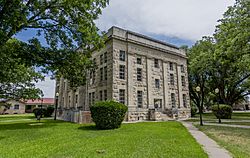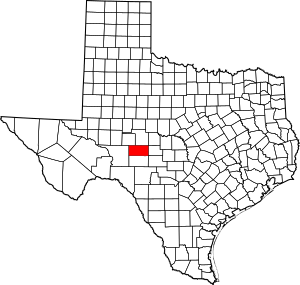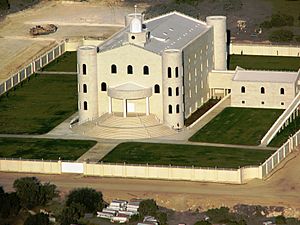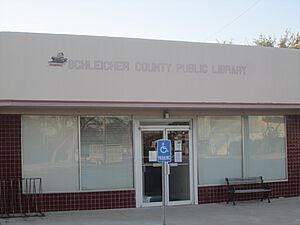Schleicher County, Texas facts for kids
Quick facts for kids
Schleicher County
|
|
|---|---|

Schleicher County Courthouse in Eldorado
|
|

Location within the U.S. state of Texas
|
|
 Texas's location within the U.S. |
|
| Country | |
| State | |
| Founded | 1901 |
| Named for | Gustav Schleicher |
| Seat | Eldorado |
| Largest city | Eldorado |
| Area | |
| • Total | 1,311 sq mi (3,400 km2) |
| • Land | 1,311 sq mi (3,400 km2) |
| • Water | 0.03 sq mi (0.08 km2) 0% |
| Population
(2020)
|
|
| • Total | 2,451 |
| • Density | 1.8696/sq mi (0.7218/km2) |
| Time zone | UTC−6 (Central) |
| • Summer (DST) | UTC−5 (CDT) |
| Congressional district | 23rd |
Schleicher County is a place in Texas, located on the Edwards Plateau. In 2020, about 2,451 people lived here. The main town, or county seat, is Eldorado. The county was officially formed in 1887 and started working as a county in 1901. It's named after Gustav Schleicher, who was a German immigrant, a surveyor (someone who maps land), and a politician.
Contents
History of Schleicher County
Around 8000 BC, the first people living in this area were likely Jumano Indians. Later, Lipan Apaches and Comanches also lived here. In 1632, two friars, Fray Juan de Salas and Father Juan de Ortega, worked as missionaries among the Jumanos. A soldier named Francisco Amangual explored this area in 1808. In 1882, Christopher Columbus Doty became the first person to live permanently in Schleicher County.
How Schleicher County Was Formed
The Texas Legislature created Schleicher County in April 1887. It was made from parts of Crockett County. The county was named to honor Gustav Schleicher. By 1890, the county had 155 people. Most of them were White, with a few Black and American Indian residents.
Early Settlements and Growth
In 1894, the first public school in the county opened in a place called Verand. Later, this school moved to Eldorado. The next year, W. B. Silliman started the Eldorado community. He named it after a mythical city of gold. To get people to move there, he offered free land lots to those living in nearby Verand.
In 1930, the Panhandle and Santa Fe Railway Company continued building a railroad. This made it easier to travel to nearby cities like San Angelo and Sonora. On February 27, 1941, the West Texas Woolen Mills factory in Eldorado had a big opening party. There was a parade and a BBQ lunch. About 5,000 people came to celebrate. Governor "Pappy" W. Lee O'Daniel was a special guest speaker.
Oil Discoveries and New Facilities
In the 1950s, oil was found on school lands in Schleicher County. This money helped the county build new facilities for students. They built a new library and a gymnasium.
Geography of Schleicher County
Schleicher County covers a total area of about 1,311 square miles.
Main Roads in the County
Neighboring Counties
- Tom Green County (north)
- Menard County (east)
- Sutton County (south)
- Crockett County (west)
- Irion County (northwest)
- Kimble County (southeast)
Population of Schleicher County
| Historical population | |||
|---|---|---|---|
| Census | Pop. | %± | |
| 1890 | 155 | — | |
| 1900 | 515 | 232.3% | |
| 1910 | 1,893 | 267.6% | |
| 1920 | 1,851 | −2.2% | |
| 1930 | 3,166 | 71.0% | |
| 1940 | 3,083 | −2.6% | |
| 1950 | 2,852 | −7.5% | |
| 1960 | 2,791 | −2.1% | |
| 1970 | 2,277 | −18.4% | |
| 1980 | 2,820 | 23.8% | |
| 1990 | 2,990 | 6.0% | |
| 2000 | 2,935 | −1.8% | |
| 2010 | 3,461 | 17.9% | |
| 2020 | 2,451 | −29.2% | |
| U.S. Decennial Census 1850–2010 2010 2020 |
|||
In 2000, there were 2,935 people living in Schleicher County. There were 1,115 households and 817 families. The population density was about 2 people per square mile.
About 34.3% of households had children under 18 living with them. Most households (62.6%) were married couples. The average household had 2.59 people.
The population's age breakdown was:
- 27.9% were under 18 years old.
- 7.3% were from 18 to 24 years old.
- 24.0% were from 25 to 44 years old.
- 24.4% were from 45 to 64 years old.
- 16.4% were 65 years or older.
The average age in the county was 39 years.
Between 2010 and 2020, the population of Schleicher County went down to 2,451. This 29.2% decrease was one of the largest drops among all counties in the U.S.
Communities in Schleicher County
Cities
- Eldorado (This is the main town and county seat.)
Small Towns and Areas
See also
 In Spanish: Condado de Schleicher para niños
In Spanish: Condado de Schleicher para niños



